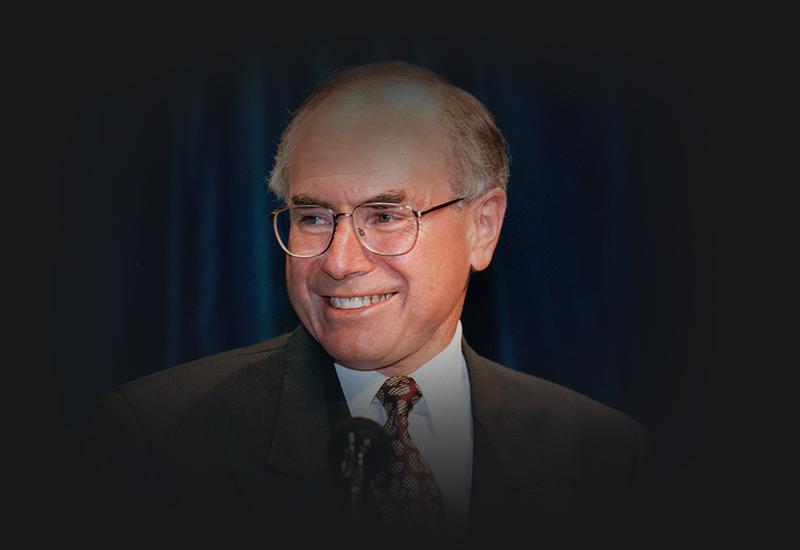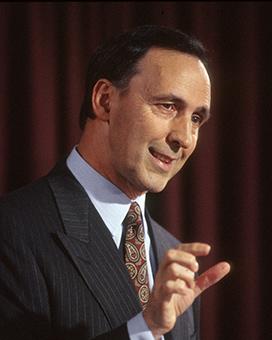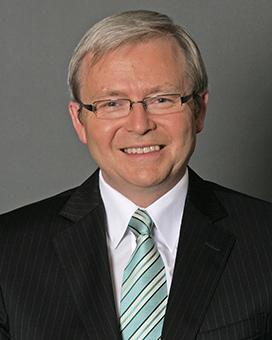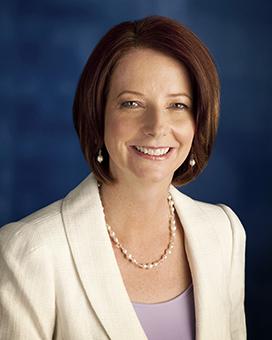John Winston Howard contested 14 federal elections from 1974, when he first won the seat of Bennelong, until 2007 when he lost it.
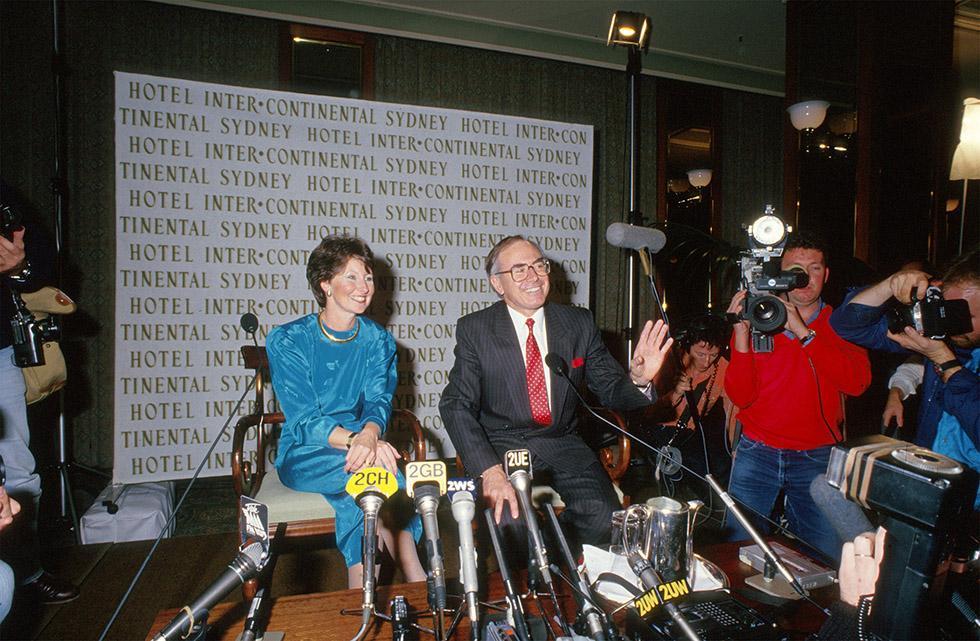
Janette and John Howard at the Liberal Party election night gathering at Sydney's Hotel Intercontinental, 11 July 1987. NAA: A6135, K7/8/87/19
18 May 1974
At this double dissolution election the Labor Party remained in government with 66 House of Representatives seats, to 40 Liberal Party and 21 Country Party seats. Howard entered parliament as the Member for Bennelong. The new Senate was evenly balanced, with Labor holding 29 seats, the Liberal Party 23 and the Country Party 6. The balance of power was held by Independent Brian Harradine and South Australian Senator Steele Hall, representing the Liberal Movement.
13 December 1975
This double dissolution election was held after Governor-General Sir John Kerr dismissed the Labor government and commissioned Malcolm Fraser as Prime Minister on 11 November. The Coalition government of Fraser and Doug Anthony was elected with a resounding majority. The Liberal Party won 68 seats to Labor’s 36, with the National Country Party (formerly the Country Party) winning 23 seats. Howard held his Bennelong seat. At the 1975 double dissolution election, 64 Senate seats were contested after 2 Senate seats each were created for the Northern Territory and the Australian Capital Territory. In the Senate, 27 Liberal and 27 Labor senators were elected, with 7 National Party, 1 Independent and 1 each from the Liberal Movement and the Country Liberal Party.
10 December 1977
Howard was again returned for Bennelong and the Fraser–Anthony Coalition government maintained its strong majority in the House of Representatives, winning 67 seats to the Labor Party’s 38, with 19 seats going to the National Country Party. In the Senate, the government improved its position slightly, winning 16 seats to Labor’s 14, with the National Country Party and the Country Liberal Party winning 1 seat each. The Australian Democrats entered parliament for the first time, winning 2 Senate seats.
18 October 1980
The government remained in office, although Liberal Party House of Representatives seats decreased to 54, with the National Party winning 20 seats. Labor increased to 51 seats. Howard retained the Bennelong seat. In the Senate, the government won 12 seats, the Labor Party 15, with 2 National Country Party, 1 Country Liberal Party and 1 Independent. The Australian Democrats increased their seats to 3.
5 March 1983
This was the fifth double dissolution federal election, and the third in 9 years. Labor gained government in a landslide win of 75 seats in the House of Representatives to the Liberal Party’s 33 and National Party’s 17. Labor also increased its Senate seats to 30. The Liberal Party won 23 seats, the National Party 4, the Country Liberal Party 1 and 1 Independent. The Australian Democrats won 5 Senate seats.
Although Malcolm Fraser held his House of Representatives seat of Wannon with a comfortable majority, he resigned from parliament on 31 March after resigning from the Liberal leadership 3 weeks earlier to Andrew Peacock. Howard was again returned for Bennelong and remained deputy leader of the party.
1 December 1984
The Hawke government called an early election, partly to merge the elections for each House once more and avoid having separate elections within the same year. In the enlarged House of Representatives, the Labor Party won 82 seats, the Liberal Party 45 and the National Party 21. In the Senate, Labor won 20 seats, the Liberal Party 16 seats, the National Party 3, the Northern Territory Country Liberal Party 1, the Australian Democrats 5 and the Nuclear Disarmament Party 1.
11 July 1987
Prime Minister Bob Hawke obtained a double dissolution of parliament – the sixth since 1901. The Labor Party increased its majority in the House of Representatives with 86 seats to 43 Liberal and 19 National Party seats. In the Senate, Labor won 32 seats, the Liberal Party 27, the National Party 6, the Northern Territory Country Liberal Party 1, and the Australian Democrats 7. The Nuclear Disarmament Party, the Vallentine Peace Group and the Brian Harradine Group each returned 1 senator.
24 March 1990
The Liberal Party increased its strength in the House of Representatives to 55 seats, with John Howard holding Bennelong comfortably. The National Party won 14 seats, Labor 78 and there was 1 Independent. In the Senate, Labor won 15 seats, the Liberal Party 16 seats and the National Party 2, with 1 Northern Territory Country Liberal Party senator. The Australian Democrats won 5 seats and the Western Australia Greens 1.
13 March 1993
Paul Keating had replaced Bob Hawke as leader of the Labor Party in 1991, and led the Labor government in an increase to 80 House of Representatives seats, with the Liberal Party winning 49, the National Party 16 and 2 Independents. In the Senate, the Liberal Party won 15 seats and the National Party 3, with 1 Northern Territory Country Liberal Party senator, to 17 Labor seats. The Australian Democrats won 2 seats, and the Western Australia Greens and the Brian Harradine Group each had 1 senator.
2 March 1996
Howard led the Liberal Party in a landslide victory of 75 House of Representatives seats. Labor won 49 seats, the National Party 19, and 5 seats were won by Independents. In the Senate, the Liberal Party won 17 seats and the National Party 2, with 1 Northern Territory Country Liberal Party senator. Labor won 14 seats, the Australian Democrats 5 and the Tasmanian Greens 1.
3 October 1998
In the House of Representatives the Liberal Party won 64 seats, the National Party 16, and the Labor Party 67, with 1 Independent. In the Senate, Labor won 17 seats, the Liberal Party 15 seats and the National Party 1, with 1 Northern Territory Country Liberal Party senator. The Australian Democrats won 4 seats, and Brian Harradine 1. The One Nation Party won 1 of the Queensland Senate seats.
10 November 2001
The Liberal Party increased its House of Representatives seats to 69, the National Party won 13 seats, the Labor Party 65, and there were 3 Independents. In the Senate, Labor won 14 seats, the Liberal Party 17 seats and the National Party 2, with 1 Northern Territory Country Liberal Party senator. The Australian Democrats won 4 seats, and the Australian Greens 2. The One Nation Party won 1 of the Queensland Senate seats.
9 October 2004
The Coalition again increased its majority in the House of Representatives. The Liberal Party won 74 seats, the National Party 12 and the Northern Territory Country Liberal Party 1. The Labor Party won 60 seats and 3 Independents were elected. In the Senate, the Coalition parties won 21 seats. The Labor Party won 16 seats, the Australian Greens won 2 seats and the Family First Party won 1 seat in Victoria. When the new senators took their seats in July 2005, the government parties had a majority in the Senate for the first time since 1981.
24 November 2007
The Liberal–National Party Coalition lost government when the Australian Labor Party won a clear majority in the House of Representatives, winning 83 of the 150 seats. The Liberal Party won 55 seats, the National Party 10, and 2 Independents were elected. Howard lost his seat of Bennelong with a swing to Labor of over 16%, making Australia’s 42nd federal election the second where a sitting prime minister was voted out of his own seat. The first was the 12th federal election in 1929. Of the 40 Senate seats contested, the Labor Party won 18, the Liberal Party 15, the National Party 2 and the Greens 3. One of the 2 Territory seats went to the Country–Liberal Party and there was one successful non-affiliated candidate.
Sources
These brief election results relate only to this Prime Minister. They are drawn from the online sources below, where further information can be found.
Australian Electoral Commission: Election results
University of Western Australia: Australian Government and Politics Database

